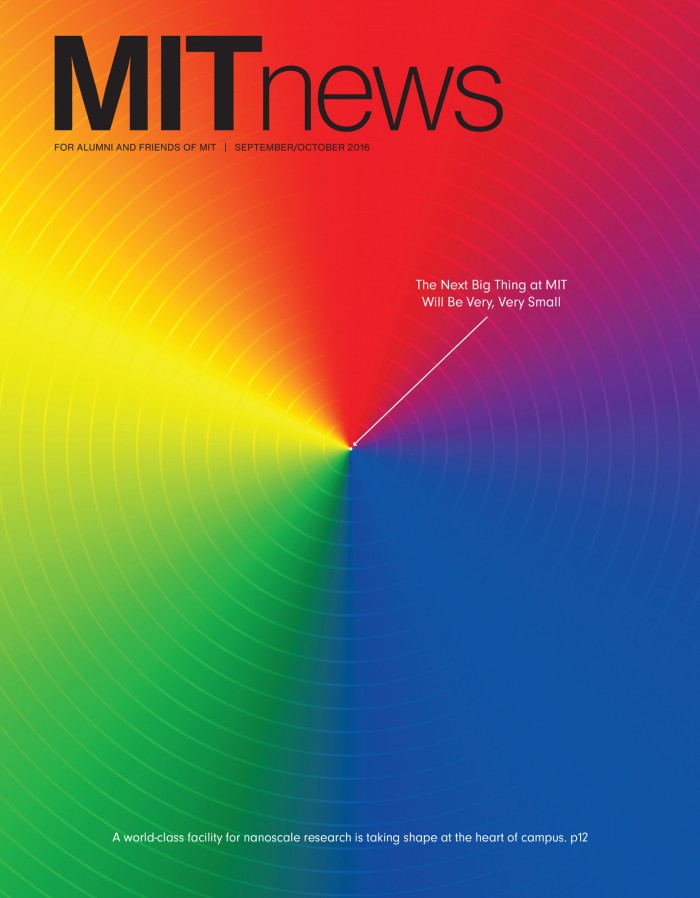Letters
Building MIT.nano
As the mit.nano facility takes shape within its glass curtain wall (“The Next Big Thing at MIT Will Be Very, Very Small,” September/October 2016), the MIT.nano team is making sure that the community input so meticulously gathered and incorporated into the construction plans is being carried out. For example, throughout construction, we have been precisely measuring the vibrational and electrical noise at the site of the imaging suites. This will help us address any noise sources before the building opens, to assure that MIT.nano’s tools perform optimally.

As we install the last of the 602 panes of exterior glass, prepare to “close in” the clean-room envelope, and install 35.6 miles of piping, 190 miles of electrical wiring, and 800,000 pounds of sheet-metal ductwork, we look forward to June of 2018, when researchers will begin using this remarkable new space.
Dennis Grimard
Associate Operations Director, MIT.nano
Free Trade’s Global Impact
I enjoyed “The Trade-Offs of Free Trade” (September/October 2016) and am delighted that David Autor is actively analyzing this “hot potato” topic. But I am a little disappointed by his narrow perspective.
I went to high school in the Southeast and watched textile mills, tire companies, and light manufacturing plants close down. At MIT I saw the remnants of Boston’s old mills being converted into condos and offices. As a consultant in the Midwest, I witnessed the demise of steel companies, auto parts suppliers, plastics fabricators. It’s been happening since the Industrial Revolution began. Free trade is “free” precisely, in part, because it is free to move to a region of comparative advantage.
In 2003 I started importing items manufactured in China at a fraction of the cost required to make them here. “Middlemen” like me, customers (U.S. manufacturing and assembly plants), retailers, and consumers have all profited. But we are the tip of the iceberg. As many as 600 million Chinese people have been lifted from abject poverty, no longer haunted by concerns about food, clothing, and shelter. Most Chinese people my age (60) have vivid memories of hunger, cold, misery, starvation. My best Chinese employee’s brother starved to death!
I am sympathetic to the out-of-work furniture maker in Hickory, North Carolina, but I’m proud of the ex-peasant girl from Sichuan who now has an apartment and owns a car. When it comes to the economics of free trade, we should think and analyze globally. I hope that David Autor agrees and finds a way to include this dimension in his economic analyses.
John V. Busch, SM ’83, PhD ’87
Waltham, Massachusetts
Professor Autor responds:
I appreciate and concur with the thrust of Dr. Busch’s letter and am glad to expand on that point here. Over two decades, trade integration between the developed and developing world—particularly between the West and China—has produced large aggregate gains in GDP in rich and poor countries alike. China’s rise has probably done more to alleviate global poverty and reduce world inequality than any other economic event in centuries. The positive impact on Chinese citizens is abundantly evident. Moreover, China’s growth generated a commodity boom that spread prosperity across South America and parts of South Asia and Southeast Asia. China has also emerged as Africa’s largest trading partner and has made large direct investments in Africa, often in some of the poorest countries, from which Western investors have historically shied. These gains dramatically exceed the consequential but comparatively modest adverse impact on U.S. manufacturing workers.
No policy can fully shield workers from the challenges of trade adjustment and allow nations to realize all the benefits. But as discussed in the article, the U.S. could do much more to assist the workers and communities most hurt without negating the gains to the nation and the world.
Robo Traffic
Reading the recent issue, i am struck by two seemingly connected new technologies: robo-cars and swarms of mini-bots.
Robotic cars are here now, as evidenced by major discussions in your magazine and regular features in the Boston Globe and on CNN. And Radhika Nagpal’s collaborating robot swarms (“Robo Swarm,” September/October 2016) reminded me of my reaction to fellow grad students’ research on traffic patterns, including the idea of “gravity waves” surging through large traffic flows, caused by individual and independent thinkers behind each wheel. I recall thinking that swarms of self-driving cars, all with independent brains and unique operating parameters and time coefficients, would generate unheard-of traffic crises.
Nagpal’s work might apply to such a scenario directly: if swarms of robo-cars could communicate and work together, not only could potentially spectacular gridlock disasters be averted, but travel time might even be made more efficient.
Cliff Henricksen, SM ’68
Framingham, Massachusetts
Correction
We regret that the profile of Bob Anslow ’54 in the September/October print issue ran with the wrong photo. His profile also appears in the November/December issue so print readers can see what Bob really looks like.
Tell us what you think
E-mail mitnews@technologyreview.com
Write MIT News, One Main Street, 13th Floor, Cambridge, MA, 02142
Keep Reading
Most Popular
Large language models can do jaw-dropping things. But nobody knows exactly why.
And that's a problem. Figuring it out is one of the biggest scientific puzzles of our time and a crucial step towards controlling more powerful future models.
The problem with plug-in hybrids? Their drivers.
Plug-in hybrids are often sold as a transition to EVs, but new data from Europe shows we’re still underestimating the emissions they produce.
Google DeepMind’s new generative model makes Super Mario–like games from scratch
Genie learns how to control games by watching hours and hours of video. It could help train next-gen robots too.
How scientists traced a mysterious covid case back to six toilets
When wastewater surveillance turns into a hunt for a single infected individual, the ethics get tricky.
Stay connected
Get the latest updates from
MIT Technology Review
Discover special offers, top stories, upcoming events, and more.